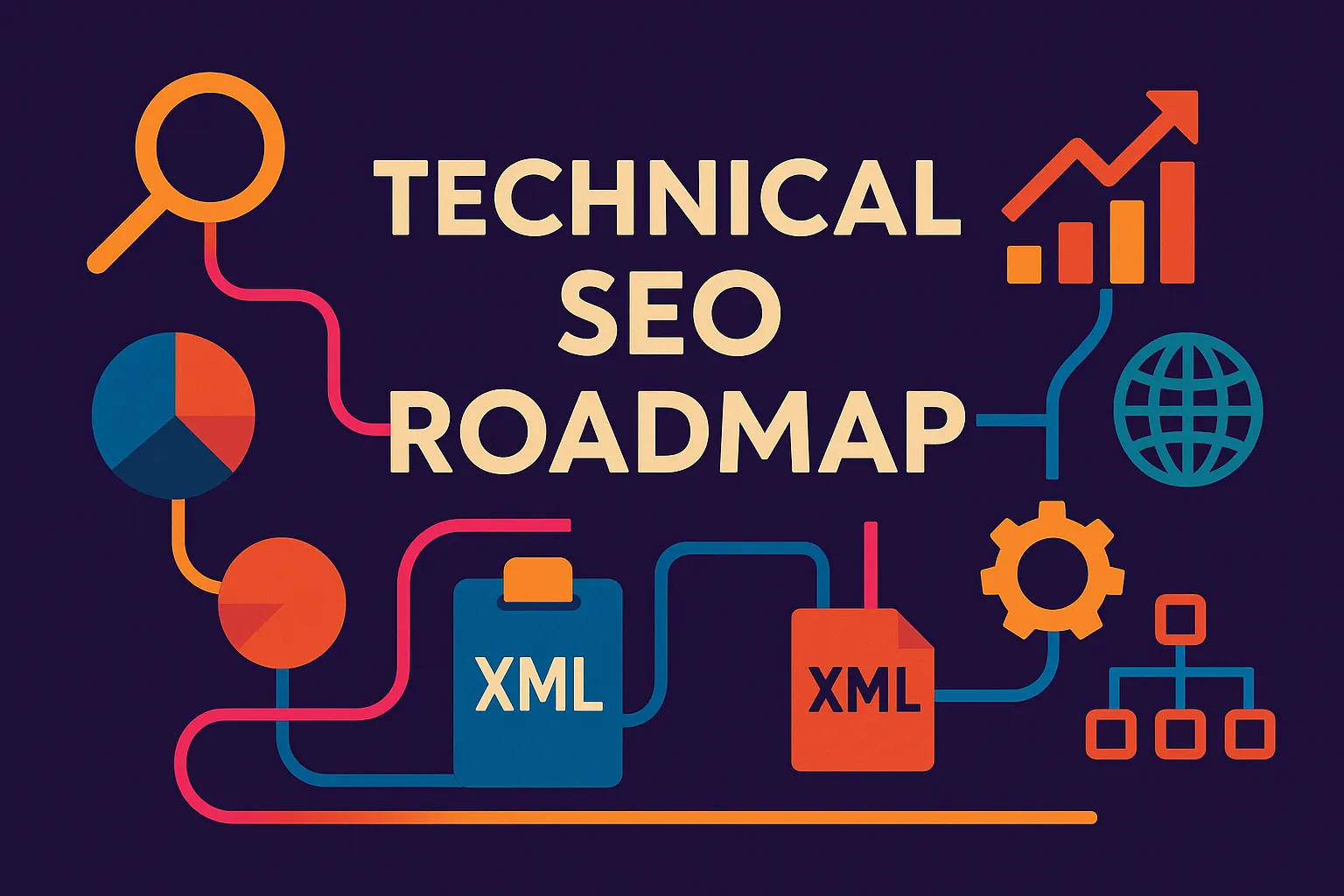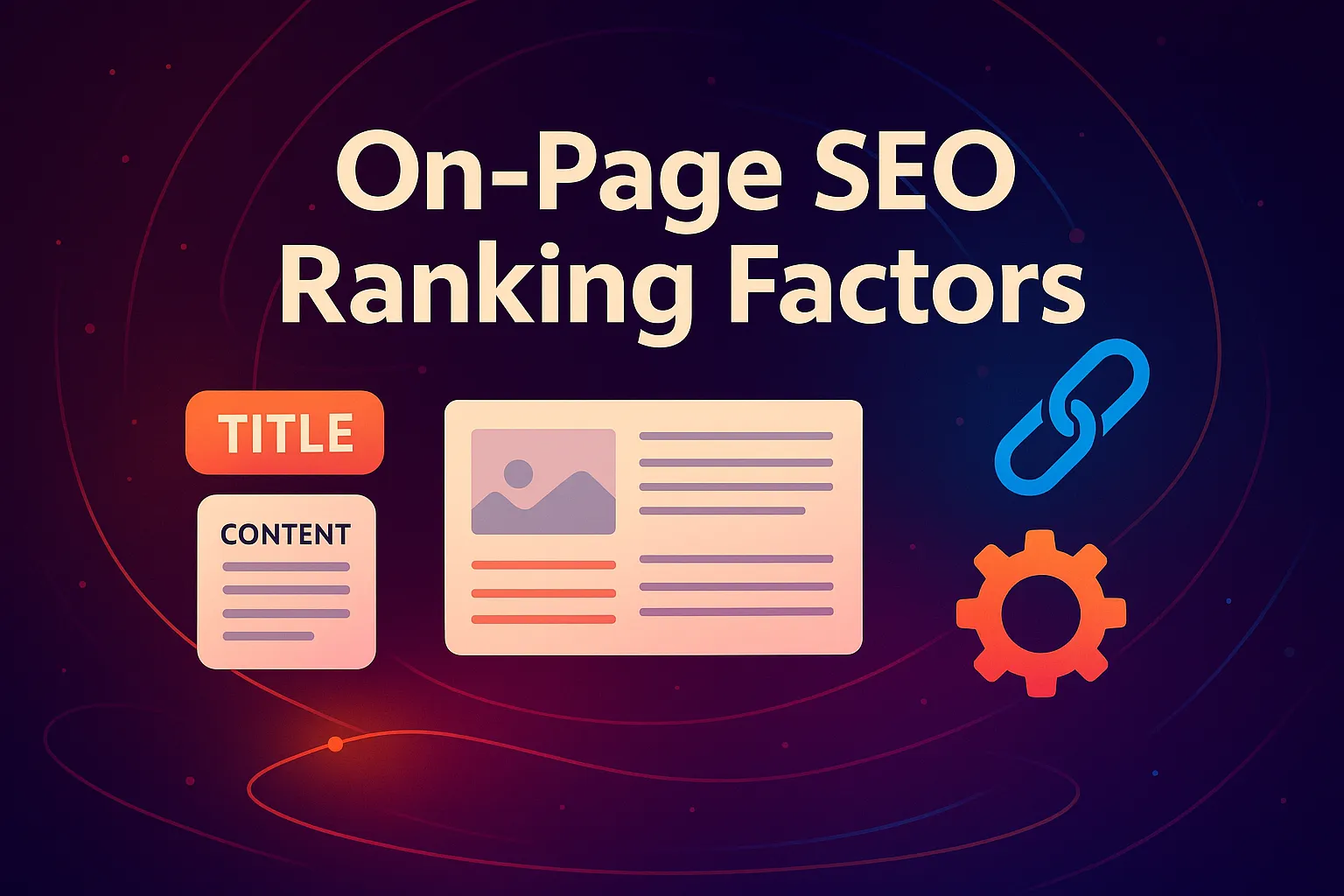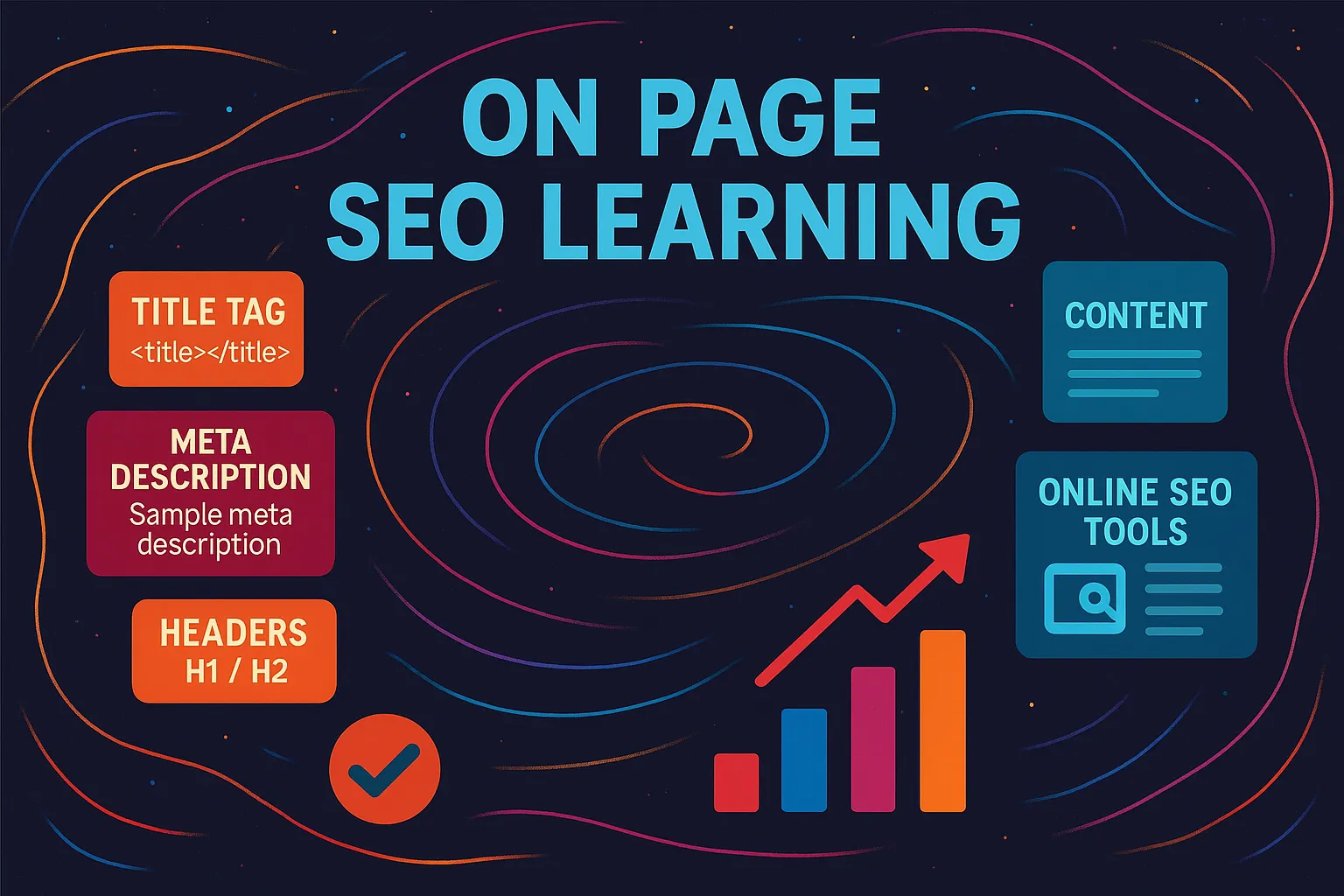What Is a Technical SEO Roadmap?
At its core, a technical SEO roadmap is like the GPS for your website’s SEO success. It tells you where to go, how to get there, and what roadblocks to avoid.
Unlike content marketing or backlinks, technical SEO focuses on the health and performance of your site from the inside out. It’s about things like load speed, mobile-friendliness, crawl errors, and making sure your pages are indexable by search engines.
When we work with a client at Vibe Branding, the first thing we do is run a technical SEO audit. Why? Because even the best content can fail if the site architecture is broken or sluggish.
This roadmap keeps everyone on the same page—literally and figuratively—so developers, designers, and marketers don’t step on each other’s toes. Think of it as your blueprint for success.
And just like a real blueprint, it needs to be updated regularly. If you don’t have one yet, don’t worry.
Let’s build it together.
TL;DR
- A technical SEO roadmap is your step-by-step guide to making your website faster, more crawlable, and Google-friendly.
- It aligns your SEO tasks with developers, marketers, and business goals.
- Includes auditing site issues, using tools like Screaming Frog or PageSpeed Insights, and prioritizing fixes.
- Helps you stay ahead of Google algorithm changes and Core Web Vitals.
- I’ll share how we build them at Vibe Branding using 10+ years of digital marketing experience.
Why Your Website Needs One
I’ve seen websites with killer content and high-quality backlinks still struggle to rank. The culprit?
Technical SEO issues. Broken links, no SSL, or even a missing sitemap can quietly sabotage everything.
That’s why having a technical SEO roadmap is critical. It helps avoid these hidden landmines.
Over the past decade, our team has worked with ecommerce sites, SaaS startups, and service-based businesses across the U.S. One common pattern? Those with a documented, structured approach to technical SEO always outperformed those without one.
Your roadmap isn’t just about fixing problems; it’s about future-proofing your site. It also brings clarity. Instead of reacting to problems as they come, you’re being proactive.
You know which issues to tackle first, and why they matter. Most importantly, you can measure success.
That’s what separates wishful thinking from real results.

The Core Elements of a Solid Technical SEO Roadmap
Let’s walk through what should actually go into your technical SEO roadmap. These are the non-negotiables we include when building a strategy at Vibe Branding.
First, indexability and crawlability. You want Google’s bots to easily find and understand your site.
That means setting up your robots.txt, cleaning up crawl errors, and having a solid XML sitemap. These are the basics, but you’d be surprised how often they’re overlooked.
Second, performance. Site speed is everything.
Google has made it clear: slow websites don’t rank. You need to compress images, minify code, and prioritize fast hosting.
We use PageSpeed Insights and Web.dev to benchmark this for every client. Next up: mobile optimization.
With mobile-first indexing now the standard, your site needs to work flawlessly on every screen size. Responsive design, proper viewport settings, and tap-friendly buttons are a must.
Structured data, or schema markup, is another core element. It helps search engines better understand your content.
You’ll also want error-free 404 pages, proper use of canonical tags, and breadcrumb navigation for easier UX and crawling. Finally, you need regular audits and tracking.
Use tools like Screaming Frog or Ahrefs to monitor everything. And build a cadence—monthly or quarterly—to check and update your roadmap.
How to Run a Site Audit Before You Build Anything
Every technical SEO roadmap starts with a complete audit. I personally love using Screaming Frog for this.
It gives us a full crawl of your site, showing everything from redirect chains to missing meta tags. But it’s not just about tools—it’s about knowing what to look for.
Start with Google Search Console. It’ll flag indexation issues, mobile usability errors, and Core Web Vitals performance.
This is where we pull baseline data. Next, run a site crawl.
Screaming Frog shows you broken links, duplicate content, orphaned pages, and much more. We also check internal linking structure, load speed, and server response times.
If it takes more than 3 seconds for your page to load, you’re already behind. Finally, we look at structured data errors and opportunities for schema markup.
Here’s what a typical audit result might look like:
Category | Issues Found | Priority |
Crawl Errors | 142 pages blocked by robots.txt | High |
Page Speed | Average TTFB: 2.9s | High |
Mobile Usability | 6 pages with tap targets too close | Medium |
Broken Links | 22 internal 404s | High |
Structured Data | Missing on 10 blog posts | Medium |
You can’t fix what you don’t know. That’s why this audit phase is so crucial. Once the data is collected, we start building your roadmap
The Tools We Use to Build and Execute
At Vibe Branding, we’re tool-agnostic, but some platforms are just too good to ignore. To build and maintain a technical SEO roadmap, we usually rely on a combo of Google tools and third-party platforms.
We use Google Search Console for real-time crawl and index data. Google PageSpeed Insights helps us track Core Web Vitals. Screaming Frog is our go-to for deep technical crawls, and GTmetrix for waterfall load times and historical tracking.
For structured data, we love the Rich Results Test and Schema.org. For reporting and dashboards, we build everything out in Looker Studio.
This makes it easy for clients to see what’s been fixed and what’s still in progress. Project management platforms like Asana and Monday.com help us assign technical SEO tasks to devs and keep the whole roadmap moving.
We also use Surfer for content gap audits, which sometimes uncover technical barriers to ranking. And yes—Excel or Google Sheets are still incredibly useful when mapping out priority lists, task owners, and timelines.
Never underestimate a clean spreadsheet.

How We Prioritize What to Fix First
One of the most important steps in creating a technical SEO roadmap is deciding what to fix first. This is where strategy meets speed.
We use a variation of the Eisenhower Matrix, which ranks tasks by impact and urgency. For example, if your site has crawl errors or is blocking pages in robots.txt, that’s both urgent and high impact.
Fix it now. If your site loads in 4.5 seconds?
That’s hurting rankings and user experience—also urgent. Less urgent but still important?
Things like schema updates or switching to breadcrumb navigation. These get slotted for later phases.
We also look for low-effort, high-reward tasks. Fixing alt tags or compressing large images can sometimes yield quick improvements.
Here’s a basic prioritization logic:
- High Impact + Low Effort = Fix first
- High Impact + High Effort = Schedule next
- Low Impact + Low Effort = Batch tasks
- Low Impact + High Effort = Consider skipping
This helps avoid overwhelm. You don’t need to fix everything at once.
Just focus on the right things at the right time.
The Most Common Technical SEO Problems We See
Over the years, we’ve seen hundreds of audits. Some issues are surprisingly common.
The first? Crawlability. Robots.txt files blocking important pages.
Noindex tags on product listings. It’s the digital equivalent of locking your store and forgetting the key.
Next is site speed. Giant image files, bloated JavaScript, or poor hosting choices can drag your site down.
And yes, Google is watching. Especially with the introduction of Core Web Vitals, speed now directly affects rankings.
Mobile usability is another big one. Elements that don’t render properly, fonts that are too small, or buttons that overlap.
These errors are flagged in Search Console, but too many folks ignore them. Duplicate content issues are a silent killer.
They split authority and confuse search engines. Often caused by parameterized URLs or lazy canonical tag usage.
Finally, there’s misused structured data. No schema, or worse, broken schema.
We’ve seen sites penalized because their rich snippets were misleading. Always validate before pushing live.
How Often Should I Revisit My Technical SEO Roadmap?
If there’s one thing I’ve learned in 10 years of digital marketing, it’s that SEO never sits still. Algorithms change. Core Web Vitals evolve.
Google quietly updates how they evaluate your site performance—so your technical SEO roadmap can’t be static either. At Vibe Branding, we revisit our clients’ roadmaps at least once a quarter.
But if you’re actively scaling your website, adding new products, or publishing lots of content, monthly reviews are even better. You don’t want to realize something broke only after traffic drops.
During each check-in, we review progress on previously outlined tasks, assess new audit data, and reprioritize based on recent insights. For example, a slow server might not have been a priority three months ago—but if bounce rates spike, it moves to the top of the list.
This iterative approach keeps your strategy fresh and responsive. Plus, it helps with long-term planning.
Some issues, like a CMS migration or HTTPS implementation, might need multi-month timelines. Your roadmap should evolve with your business—not sit in a drawer collecting digital dust.

Aligning Your Roadmap with Google’s Core Web Vitals
Google has been loud and clear: site experience matters. The introduction of Core Web Vitals made that official.
So when building your technical SEO roadmap, aligning it with these metrics is non-negotiable. The three pillars of Core Web Vitals are:
- Largest Contentful Paint (LCP): How quickly the main content loads.
- First Input Delay (FID): How fast users can interact.
- Cumulative Layout Shift (CLS): How stable your layout is as it loads.
We monitor these using PageSpeed Insights and Chrome UX reports. If we see LCP consistently over 2.5 seconds or layout shifts above 0.1, we flag it.
These metrics not only affect user experience—they directly impact rankings. Our developers often work closely with SEO strategists to address these.
Fixes can range from image compression and lazy loading to upgrading servers or eliminating third-party scripts. These tasks go straight into the roadmap, labeled with urgency and expected outcomes.
By baking Core Web Vitals into your roadmap, you ensure your site stays ahead—not just in rankings, but in user satisfaction too.
Metrics That Matter: Tracking the Roadmap’s Impact
Creating a roadmap is one thing. Measuring its impact?
That’s how you prove ROI. At Vibe Branding, we define success through data.
Every technical SEO roadmap is tied to a set of metrics that help us gauge progress and performance. Some of our favorites include:
- Crawl rate and indexed pages (via Google Search Console)
- Average load time and time to interactive
- Bounce rate and pages per session
- Core Web Vitals scores
- Organic keyword rankings
- Overall organic traffic
But here’s the key: we track these over time. Comparing month-to-month or quarter-to-quarter helps us spot trends.
Did bounce rate drop after speeding up mobile load times? Great.
Did keyword rankings jump after fixing crawl errors? Even better.
We also generate visual dashboards to make progress easy to share with stakeholders. Whether it’s for your internal marketing team or a C-level exec, showing results in a clear, visual format helps keep everyone invested in the roadmap.
Presenting the Roadmap to Your Team or Client
Let’s be real—technical SEO can sound… technical. That’s why presentation matters.
When we hand off a technical SEO roadmap to a client, we never dump a 12-tab spreadsheet and call it a day. Instead, we walk through the roadmap in stages.
We highlight wins, explain pain points, and break down tasks by role. Devs get their list.
Content teams get theirs. Everyone knows what’s next.
Visuals help. We use Gantt charts, flowcharts, and simplified diagrams to explain dependencies and priorities.
Even if someone’s not an SEO expert, they should still understand the roadmap’s structure and goals. Language matters too.
Instead of “LCP above threshold due to render-blocking JS,” we say, “The homepage loads slowly because of scripts that run before the main content appears.” Same issue—better understanding.
And here’s something we always recommend: set review meetings. Once the roadmap is live, set monthly or quarterly syncs to check progress and adjust course.
A roadmap isn’t a one-and-done PDF. It’s a living document, just like your website.

Bringing It All Together: Why This Matters
A technical SEO roadmap isn’t just a checklist—it’s a strategy. It’s how you go from guessing to knowing.
From reacting to leading. At Vibe Branding, we’ve built these roadmaps for startups trying to get their first traffic spike and for enterprise sites cleaning up years of technical debt.
And while the scale changes, the method doesn’t. Audit, prioritize, execute, measure, repeat.
The truth is, you can’t separate SEO from user experience anymore. Google doesn’t just want fast, crawlable sites—they want usable, delightful ones.
A strong technical SEO roadmap ensures you meet those expectations. And most importantly?
It turns chaos into clarity. It gives your team a playbook.
Your stakeholders a timeline. And your website has a fighting chance at dominating the SERPs.





